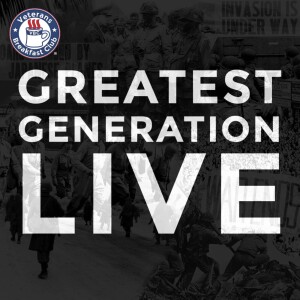
Friday Aug 02, 2024
The US Army at Guadalcanal
Glenn Flickinger leads a conversation with military historians and Pacific War experts Jeff Ballard and Dave Holland on the US Army’s role in the Battle of Guadalcanal in World War II.
Dave, a seasoned veteran with a 28-year career in the US Marine Corps, is host of the popular Guadalcanal – Walking a Battlefield YouTube channel. He shares with us his extensive knowledge and passion for the Battle of Guadalcanal. He’s dedicated especially to assisting veterans and their families seeking information about the Guadalcanal campaign. Through his extensive personal knowledge, research, and field experience, he has become a valuable resource for those interested in the Guadalcanal campaign.
Military Historian Jeff Ballard is the expert on the Navy side of the Battle of Guadalcanal, but he shares his extensive knowledge of the Army experience with us.
The battle is often highlighted as a pivotal Marine Corps operation, but it was a joint Army-Marine-Navy effort was essential in securing an Allied victory and marked a turning point in the Pacific War.
The initial stages of the battle saw the 1st Marine Division, under Major General Alexander Vandegrift, landing on Guadalcanal on August 7, 1942. They quickly captured the airfield, later named Henderson Field, and established a defensive perimeter. However, the need for reinforcements became evident as Japanese forces mounted counterattacks.
The first U.S. Army units arrived on October 13, 1942, with the 164th Infantry Regiment of the Americal Division (officially the 23rd Infantry Division) reinforcing the Marines. This regiment played a crucial role in strengthening the defensive positions around Henderson Field and repelling Japanese assaults, particularly during the intense Battle for Henderson Field in late October 1942. Their presence was instrumental in blunting the major Japanese offensive and maintaining control of the airfield.
Further Army reinforcements arrived in the following months. The rest of the Americal Division, including the 182nd and 132nd Infantry Regiments, landed in November 1942, followed by the 25th Infantry Division, comprising the 35th, 27th, and 161st Infantry Regiments, in December 1942 and January 1943. These additional troops significantly bolstered the Allied forces on the island.
Army units participated in several key operations to clear Japanese forces from Guadalcanal. They were involved in offensives in the Matanikau River area and the Battle of Mount Austen, the Galloping Horse, and the Sea Horse in January 1943. These operations, conducted in challenging terrain against tenacious Japanese resistance, were crucial in securing strategic locations on the island. The U.S. Army’s role in these battles was vital for the overall success of the campaign.
The coordination between Army and Marine Corps units was a critical factor in the success of the Guadalcanal campaign. Both branches worked closely, coordinating attacks, sharing resources, and supporting each other in defensive operations. This integration helped to overwhelm Japanese forces and maintain control of critical areas, such as Henderson Field. The combined efforts of Army and Marine Corps units ensured that the Allies could sustain their offensive and defensive operations effectively.
By February 1943, Japanese forces were evacuated from Guadalcanal, marking the successful conclusion of the campaign. The U.S. Army’s involvement was essential in maintaining the momentum and ensuring the eventual Allied victory on the island. While the Marine Corps led the initial stages, the contributions of the U.S. Army were vital in reinforcing and sustaining the effort, ultimately securing a decisive victory for the Allies.
In summary, the Battle of Guadalcanal was a joint effort where the U.S. Army’s significant contributions complemented the Marine Corps’ operations. The Army’s participation in critical battles, reinforcements, and coordination with the Marine Corps were key factors in the eventual success of the campaign, highlighting the importance of unified efforts in achieving victory.
We’re grateful to UPMC for Life and Tobacco Free Adagio Health for sponsoring this event!
#militaryhistory #veteran #interview #veterans #vet #veteransbreakfastclub #vbc #virtualevents #virtual #zoom #zoomevents #liveevent #webinar #military #army #usarmy #navy #usnavy #marinecorps #marines #airforce #pilot #aviators #coastguard #nonprofit #501c3 #history #militaryveterans #veteransstories #veteranshistory #veteraninterview #veteranshistoryproject #veteransoralhistory #veteranowned #militaryretirees #armyretirees #navyretirees #warstories #vietnam #vietnamwar #vietnamveterans #koreanwar #coldwar #greatestgeneration #wwii #ww2 #worldwarii #worldwar2 #war #americanhistory #oralhistory #podcast #scuttlebutt #thescuttlebutt #humor #storytelling #headlines #news #roundtable #breakfast #generation911 #happyhour
Comments (0)
To leave or reply to comments, please download free Podbean or
No Comments
To leave or reply to comments,
please download free Podbean App.